Fountains Squares Bridges Trevi Fountain | St-Peter Square | Popolo |
Saint Peter’s Square in Rome and Bernini’s Colonnade
Saint Peter’s Square: 284 columns, 88 pillars and 140 statues!
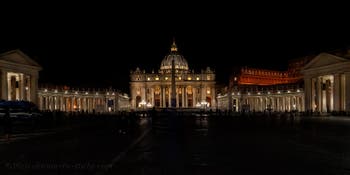
Saint Peter's Square The construction of Saint Peter’s Square lasted eleven years, from 1656 to 1667.
The square’s two arches are each made up of a quadruple row of Doric columns forming three covered traffic lanes with a total width of 17 meters.
A total of 284 columns and 88 pillars make up this architectural ensemble.

Saint Peter's Square If you place on one of the two marble discs located between the obelisk and the two fountains, the four columns arranged along the two wings become one, the first hiding the other three.
A visual effect that was wanted by Bernini, who, to achieve this, made sure that the diameter of each row of columns increased laterally from one column to the next, the inner column of the wings, the one we see is the one with the largest diameter.
These columns are 16 meters high, with a diameter of up to 1.42 meters.
Saint Peter’s Square: 140 statues of Saints and Martyrs
Ninety-six statues of Saints and Martyrs top the columns, while 44 other statues overlook the Square. The statues are 3.10 meters high, and all have their faces facing the sky while their bodies are facing the neighbouring statue.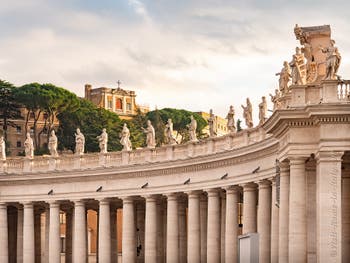
Saint Peter's Square The choice of Saints is based on a subdivision between the New and the Old Testaments.
While some statues refer to Saints who were recently canonized at the time, most represent foreign Saints.
On the North Arch and the East Arm: the statues of the “defenders of the faith.”
On the western arc: here are the founders of the oldest religious orders who contributed to the creation of monastic life.
On the South Arm and the Eastern Arch: Popes and Bishops Doctors of the Church.
Saint Peter’s Square in Rome is one and a half times the size of the Colosseum
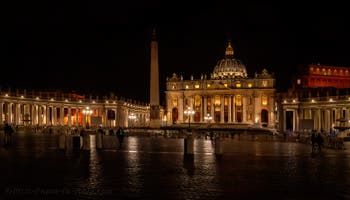
Saint Peter's Square This architectural complex is 340 meters long, from the stairs of Saint Peter’s Eve to the beginning of the Square.
A gigantic ellipse whose area is one and a half times that of the Colosseum!
The longest axis of the Colosseum’s ellipse is, in fact, 188 meters long, compared with 240 meters between the two semicircles of Bernini’s colonnades.
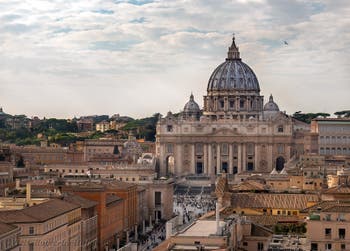
Saint Peter's Square The design of the construction of Saint Peter’s Basilica by its successive architects, San Gallo, Alberti, Bramante, Raphael, Peruzzi, San Gallo the Younger, Michelangelo, Ligorio, della Porta and Maderno, planned to leave ample empty space around it, to highlight it best.
But none of the architects who preceded Gian Lorenzo Bernini, the creator of Saint Peter’s Square, had ever imagined creating such a space that could amplify, energize, reunite, and unify the Basilica with its square in such a monumental way.
Bernini’s creation is genuinely superb, worthy of a Genius Artist
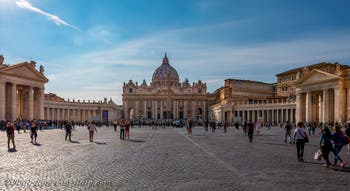
Saint Peter's Square Before Bernini’s intervention, the large atrium that represented Saint Peter’s Square, with its recently installed obelisk and fountain, had no other function than to provide sufficient space to welcome the faithful and let the basilica “breathe.”
Bernini himself did not immediately find the plan for its construction, as we can admire today.
Saint Peter’s Square was rectangular in his first projects, surrounded by buildings and passages covered by arcades and columns.
Saint Peter’s Square in Rome: from Rectangular to Oval
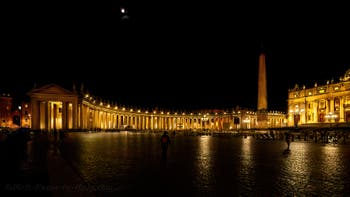
Saint Peter's Square During the successive confrontations between Bernini’s project and Pope Alexander VII, the quadrangular square became oval.
This idea of transforming a quadrangular shape into an oval shape was not even linked to the final aesthetic aspect but simply to the desire to ensure that the Pope, during his sermons and blessings from his balcony in the Vatican Palace, could be seen by all the faithful.
A quadrangular square would have had the disadvantage of hiding the Pope’s balcony from some of the faithful who came to listen and see him.
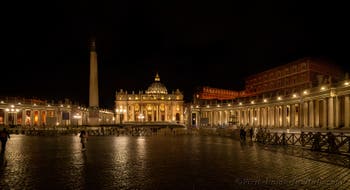
Saint Peter's Square The appearance of the Pope, until the end of the 18th century, was accompanied by a shot salvo fired from Castel Sant’Angelo's canons.
But Bernini’s idea of turning it into an oval square also came from his intention to create a powerful ensemble integrating the square, the facade of the Basilica and its superb dome.
Saint Peter’s Square, wanted by Bernini, is also not a simple oval
It is much more complex since this oval opens with two rectilinear arms that connect it directly to the Basilica.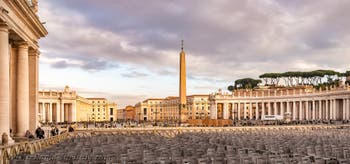
Saint Peter's Square Bernini’s architectural invention aims to better integrate the square with the Basilica in the way Michelangelo knew how to combine the Senate Palace and Capitoline Square.
Saint Peter’s Square in Rome: Two arms wide open to welcome the faithful
Bernini’s St. Peter’s Square, with its two wide open arms, welcomes and leads the faithful to the Basilica.It is also a powerful symbol in perfect harmony with the Church’s message.
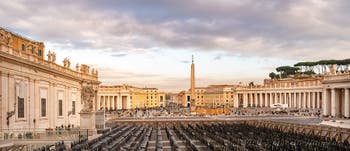
Saint Peter's Square Its two arms, formed by the arches of two intersecting circles, draw this superb open and particularly dynamic oval shape.
This monumental horizontality highlights, on the one hand, God’s dominion over the world and, on the other, an invitation to the crowd of faithful to advance towards the Basilica.
This architectural creation by Bernini also had the effect of visually increasing the height of the facade of the Basilica designed by the architect Carlo Maderno.
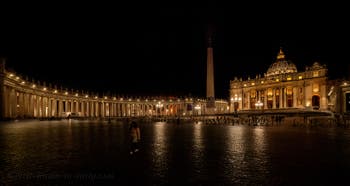
Saint Peter's Square During a trip to Paris, Bernini said that the creation of these two wings of columned arcades was also intended to visually enlarge the entrance door to the Basilica, which some, at the time, thought was too low.
The obelisk in Saint Peter’s Square
The large red granite obelisk without hieroglyphs is 25.37 meters high and weighs 330 tons.
Saint Peter's Square Placed in the centre of the Square, it completes this superb staging.
And if you count the pedestal and the cross that tops the obelisk, the total height is 40.28 meters.
It is the second-highest obelisk in Rome.
It was brought to Rome from Alexandria by the emperor Caligula, who installed it in his circus.
It later became the Circus of Nero, a circus located on the site of the current sacristy.
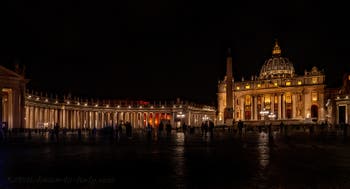
Saint Peter's Square It is said that it was at the foot of this obelisk that Saint Peter was martyred.
Pliny explains that a 400-ton boat was specially built to bring the obelisk to Rome.
On this boat, four granite blocks and 2,800,000 pounds of Egyptian lentils were installed to block the obelisk best while being transported at sea.
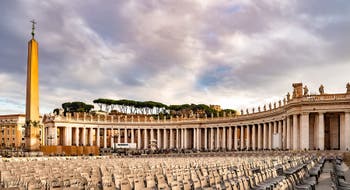
Saint Peter's Square In 1586, Pope Sixtus V, a great fan of obelisks, asked the architect Domenico Fontana to install it in Saint Peter’s Square.
A passion for obelisks dates back to the Roman emperors, so much so that there are more obelisks in Rome today than in Egypt!
Moving the Obelisk: 907 Men, 55 Horses and 40 Winches
A complex and challenging operation: it took no less than 907 men, 55 horses and 40 winches to bring it from its original location, 300 meters away, and to erect it in the centre of Saint Peter’s Square.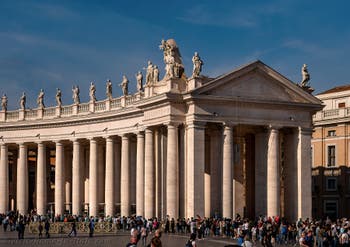
Saint Peter's Square The operation beganon April 30, 1586, and on May 7, the obelisk was on the ground where it was supposed to be erected.
Operations were then suspended due to the hot weather, and only in September was the obelisk finally erected in front of Saint Peter’s Basilica.
The Lovely Story about the Obelisk
By the way, a lovely story was also invented two centuries later.It is said that the Pope when straightening the obelisk, saw the risks involved and, to maintain maximum concentration during the delicate operation, had imposed silence on spectators and workers under penalty of death!
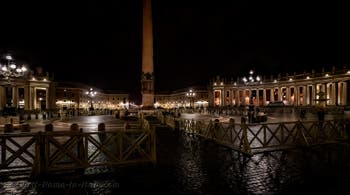
Saint Peter's Square But a sailor named Bresca, seeing the abnormal tension experienced by the ropes, would have dared to shout to wet the ropes to prevent them from breaking.
Far from imposing the death penalty on him, the legend indicates that the Pope, grateful, would have granted the sailor and his descendants the exclusive privilege of providing palm leaves to Saint Peter’s Basilica.
The Ashes of Julius Caesar and the Relic of the True Cross
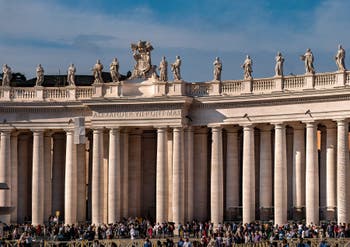
Saint Peter's Square Initially, this obelisk was surmounted by a globe into which, according to a legend dating from the Middle Ages, Caligula had Julius Caesar’s ashes placed.
But the architect Domenico Fontana, who was in charge of installing the obelisk, examined the globe himself and found that it had been melted into a single block without any opening, making it impossible to insert anything inside. End of the legend!
This globe was donated to the city of Rome by Pope Sixtus V, and it is now displayed in the Capitoline Museums.
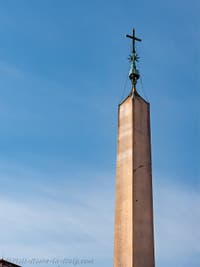
Saint Peter's Square The work stoppage between May and September was used to replace the globe with a cross.
A bronze cross containing a relic of the Holy Cross was brought to Rome from Palestine by Saint Helena.
Sixtus V also had the emblem of his family, the Peretti, placed under the cross: a mountain with three peaks topped by an eight-pointed star.
At the foot of the obelisk, in 1817, the astronomer L.G. Gilij installed a meridian with a wind rose on the ground, transforming the obelisk into a sundial.
The obelisk is supposed to represent the ideal centre.
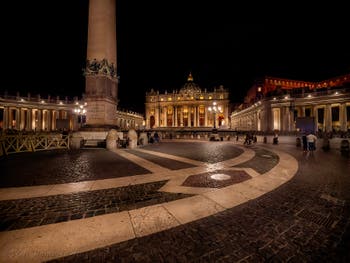
Saint Peter's Square And yet, the obelisk is not perfectly centred compared to Saint Peter's Basilica.
Indeed, it is offset by 4 meters from the median axis of the facade of the Basilica.
The explanation is simple.
When the obelisk was erected, Saint Peter's Square, bordered as it is today by Bernini's colonnade, existed only as an ample open space in which it was installed in front of the Basilica.
Bernini's colonnade had to be perfectly symmetrical in all its components to give the desired visual impression, with the obelisk in its centre, even if it is not perfectly aligned with the Basilica.
Shortly before the obelisk, there are two fountains, one built by Carlo Maderno in 1613 and the other by Gian Lorenzo Bernini in 1677, positioned perfectly symmetrically with respect to the square and the obelisk.
Fountains Squares Bridges Trevi Fountain | St-Peter Square | Popolo |
Back to Top of Page

